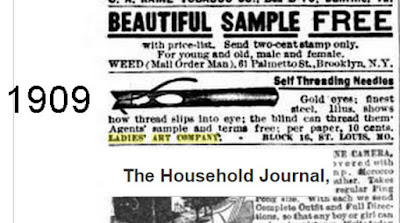Madame Deborah Grelaud advertised an
embroidery curriculum in this ad from the
Pennsylvania Gazette in the fall of 1801.
Mrs. Grelaud informs ladies inclined to learn the Science of Music that she gives lessons on the Piano Forte at her house No. 24, Filbert Street where she also keeps a Boarding School for Young Ladies who are instructed in .....Embroidery and Plain Work.
Women required to work might teach or run a school. A good education was not an absolute prerequisite and some schools had better reputations than others. One of the most fashionable girls' schools was Madame Grelaud's in Philadelphia, which took in boarders from about 1800 to 1850.
Madame's skills seem to have been musical. Her establishment was known for public musicales that entertained Philadelphia society in the evenings. Being a French emigrant from Haiti she spoke the language and offered art and geography lessons in addition to English and Arithmetic. She advertised that she was "aided by the best masters."
Academic rigor was probably not a selling point. Girls attended to become finished---eligible marriage material. Parents who hoped for a better educated graduate might choose competitor Madame Rivardi's. Among familiar names in Grelaud's alumnae lists: Washington/Custis family girls, Southern belles Varina Howell Davis and Mary Boykin Chesnut and Presidential daughters Angelica Van Buren and Maria Hester Monroe.
Madame Rivardi's school was in the Gothic Mansion on Chesnut Street
Academic rigor was probably not a selling point. Girls attended to become finished---eligible marriage material. Parents who hoped for a better educated graduate might choose competitor Madame Rivardi's. Among familiar names in Grelaud's alumnae lists: Washington/Custis family girls, Southern belles Varina Howell Davis and Mary Boykin Chesnut and Presidential daughters Angelica Van Buren and Maria Hester Monroe.
Sculptural portrait of Maria Monroe (1802-1850)
as a 15-year-old student. Collection of the James Monroe Museum
In 1810 Mme. Grelaud's Seminary was on the north side of Arch Street above 3rd, with the Second Presbyterian church on the corner.
Ornamental needlework and plain sewing were part of nearly every girl school curriculum until the mid-19th century. Madame Grelaud undoubtedly hired needlework teachers to assist her.
Henrietta Maria Ghegenise stitched this needlework picture at Madame Rivardi's in 1803.
See an online catalog of samplers with much information from Philadelphia sampler specialists M. Finkel & Daughter.
A copy of a needlework sampler wrought by
Maria Hester Monroe in 1814. I have found
little needlework attributed to Madame Grelaud's.
The original of Maria's is in the collection of the Monroe Museum
at Ash-Lawn Highland, shown in the Childrens' Room.
Shall we assume the building is the school?
Sampler worked in Philadelphia in 1823 by Margret T Child (?)
The many women who taught needlework are largely erased from the record. One good source for their names and accomplishments is the MESDA Craftsmen Database.
MESDA index card scanned
Here's a search for needleworker:
Mrs. Adams advertised in the Virginia Herald in December, 1812 about her Fredericksburg school that emphasized needlework. We assume Mrs. Adams was the needlework teacher. If you wanted a class in Arithmetick or French she charged extra and also offered:
"Young Ladies supplied with elegant patterns and their work drawn at moderate expense."
Sampler attributed to Barbara Gerz, Philadelphia.
M. Finkel & Daughter
https://issuu.com/m.finkelanddaughter/docs/finkelcatalog_fall2016_final-pgs_v1
Sampler patterns were passed on by professional teachers to their students and we have to assume patchwork and quilting patterns were too.
Sampler patterns were passed on by professional teachers to their students and we have to assume patchwork and quilting patterns were too.
Maria Hester Monroe Gouverneur, unfinished mosaic patchwork,
collection of the James Monroe Museum
Maria Hester Monroe married Samuel Laurence Gouverneur in 1820 and lived in New York City, where she pieced this hexagon quilt in the 1830s while her father President James Monroe was fatally ill. She never finished it. Her g-g-g-granddaughter donated it to the museum in Fredericksburg, Virginia.
http://jamesmonroemuseum.umw.edu/
Read more about Madame Grelaud's School here:
http://jamesmonroemuseum.umw.edu/
Read more about Madame Grelaud's School here:

























